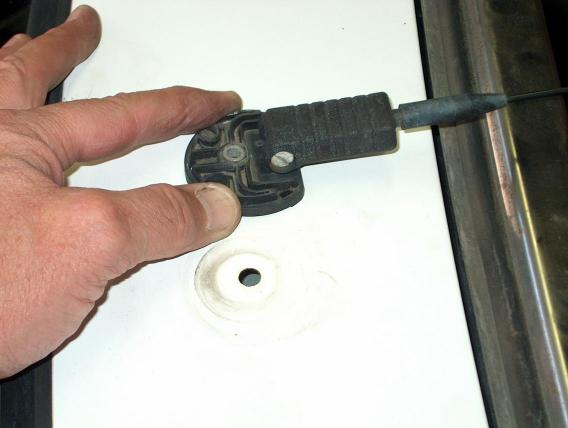
Welding up holes in the body
August 12, 2004
To start off;
I'm going to assume that you have a MIG welder and already know how to use it.
Although this applies to welding up just about any hole in the body, depending on the location of the hole some other methods may be easier. I'll talk about that at the bottom of the page.
All of the photos can be clicked to a larger format.
Why?
The prior owner had installed an aftermarket antenna on the roof, between the windshield and the sunroof opening. To do this, he drilled a hole in the roof.
I didn't like the look of the antenna (I've installed a stock one) and that meant that I had to weld up the hole.
If you are of the opinion that it's possible to just bondo up a hole, then don't bother reading the rest of this page!!
What I did;
In this photo you can see the hole in the roof and also the antenna that I removed.
First off, you have to grind it down to the metal so that you can weld to it. This includes the "edge" of the hole. Use a rat tail file to make sure.
Now I needed something to fill, or "plug" the hole. Due to the location of the hole, it's not possible to just use a backing plate, so I cut a circle out of sheet metal that was the same diameter.
Now here is the problem and also the solution to it. I couldn't hold the plug from the back side and so I used one of the "fabricators magnets" to hold it in place. (I don't know the real name for it)
The "magnet" is an arrow shaped assembly with a massive magnet between the red side plates. They are used to hold items together while welding.
You have to look closely at the above photo! What you will notice is that the plug is held in place and that an edge of it is exposed. It's this exposed edge where you throw a tack weld.
This photo isn't too clear, but it shows the plug tack welded in place. I could then finish welding around the edges of the plug.
When you do this, take your time in order to keep the heat low.
Then I used my Mikita 4" grinder to grind down the surface flush. (What looks like a small hole is just a dark area!)
After that, I tapped the area a little lower, filled it with a thin layer of bondo, sanded that down flush, and then coated that with spot putty (the red stuff).
This final photo shows it after sanding the spot putty and ready for primer / filler.
Closing comments;
If it's possible to get to the back side of the panel, it's easier to just cut a square section of sheet steel to use as a backing plate. Then you just fill the hole with weld.
return to my site's entry page
Wes Vann